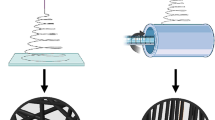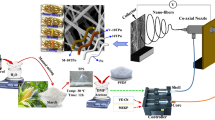Abstract
Utilizing the emulsion-forming ability of partially deacetylated chitin nanofibers, a composite with polystyrene was prepared. A partially deacetylated chitin nanofiber aqueous dispersion was added to styrene to obtain an oil in a water-type Pickering emulsion. Using the emulsion, suspension polymerization was performed to obtain polystyrene fine particles covered with chitin nanofibers. The degree of polymerization of polystyrene increased depending on the mixing ratio of chitin nanofibers. The glass transition temperature of polystyrene and the thermal decomposition temperature of the composite increased with the mixing ratio of chitin nanofibers. This composite could be molded by hot pressing, and the molded product was transparent to some extent. Since chitin nanofibers effectively reinforced polystyrene, Young’s modulus, fracture stress, and fracture strain were greatly improved. The optimum mixing ratio of chitin nanofibers for improving mechanical properties was 7%. When the composite was molded by hot pressing again, the mechanical properties did not decrease. Thus, the nanofiber reinforcement material was recyclable.
This is a preview of subscription content, access via your institution
Access options
Subscribe to this journal
Receive 12 print issues and online access
$259.00 per year
only $21.58 per issue
Buy this article
- Purchase on Springer Link
- Instant access to full article PDF
Prices may be subject to local taxes which are calculated during checkout






Similar content being viewed by others
References
Ifuku S, Nogi M, Abe K, Yoshioka M, Morimoto M, Saimoto H, et al. Preparation of chitin nanofibers with a uniform width as α-chitin from crab shells. Biomacromol. 2009;10:1584–8.
Das P, Heuser T, Wolf A, Zhu B, Demco DE, Ifuku S, et al. Tough and catalytically active hybrid biofibers wet-spun from nanochitin hydrogels. Biomacromol. 2012;13:4205–12.
Abe K, Ifuku S, Kawata M, Yano H. Preparation of tough hydrogels based on β-chitin nanofibers via NaOH treatment. Cellulose 2014;21:535–40.
Ifuku S, Ikuta A, Egusa M, Kaminaka H, Izawa H, Morimoto M, et al. Preparation of high-strength transparent chitosan film reinforcedwith surface-deacetylated chitin nanofibers. Carbohydr Polym. 2013;98:1198–202.
Izumi R, Komada S, Ochi K, Karasawa L, Osaki T, Murahata Y, et al. Favorable effects of superficially deacetylated chitin nanofibrils on the wound healing process. Carbohydr Polym. 2015;123:461–7.
Izumi R, Azuma K, Izawa H, Morimoto M, Nagashima M, Osaki T, et al. Chitin nanofibrils suppress skin inflammation in atopicdermatitis-like skin lesions in NC/Nga mice. Carbohydr Polym. 2016;146:320–7.
Azuma K, Koizumi R, Izawa H, Morimoto M, Saimoto H, Osaki T, et al. Hair growth-promoting activities of chitosan and surface-deacetylated chitin nanofibers. Int J Biol Macromol. 2019;126:11–7.
Azuma K, Osaki T, Wakuda T, Ifuku S, Saimoto H, Tsuka T, et al. Beneficial and preventive effect of chitin nanofibrils in a dextran sulfate sodium-induced acute ulcerative colitis model. Carbohydr Polym. 2012;87:1399–403.
Aklog YF, Egusa M, Kaminaka H, Izawa H, Morimoto M, Saimoto H, et al. Protein/CaCO3/chitin nanofiber complex prepared from crab shells by simple mechanical treatment and its effect on plant growth. Int J Mol Sci. 2016;17:1600.
Egusa M, Matsui H, Urakami T, Okuda S, Ifuku S, Nakagami H, et al. Chitin nanofiber elucidates the elicitor activity of polymeric chitin in plants. Front Plant Sci. 2015;6:1098.
Vincent J, Wegst U. Design and mechanical properties of insect cuticle. Arthropod Struct Dev. 2004;33:187–99.
Wada M, Saito Y. Lateral thermal expansion of chitin crystals. J Polym Sci Part B: Polym Phys. 2001;39:168–74.
Ifuku S, Morooka S, Morimoto M, Saimoto H. Acetylation of chitin nanofibers and their transparent nanocomposite films. Biomacromol. 2010;11:1326–30.
Ifuku S, Ikuta A, Hosomi T, Kanaya S, Shervani Z, Morimoto M, et al. Preparation of polysilsesquioxane-urethaneacrylate copolymer film reinforced with chitin nanofibers. Carbohydr Polym. 2012;89:865–9.
Ifuku S, Nogi M, Abe A, Handa K, Nakatsubo F, Yano H. Surface modification of bacterial cellulose nanofibers for property enhancement of optically transparent composites: dependence on ccetyl-group DS. Biomacromol. 2007;8:1973–8.
Fan Y, Saito T, Isogai A. Individual chitin nano-whiskers prepared from partially deacetylated chitin by fibril surface cationization. Carbohydr Polym. 2010;79:1046–51.
Ifuku S, Ikuta A, Egusa M, Kaminaka H, Izawa H, Morimoto M, et al. Preparation of high-strength transparent chitosan film reinforced with surface-deacetylated chitin nanofibers. Carbohydr Polym. 2013;98:1198–202.
Tzoumaki MV, Moschakis T, Kiosseoglou V, Biliaderis CG. Oil-in-water emulsions stabilized by chitin nanocrystal particles. Food Hydrocoll. 2011;25:1521–9.
Shams MI, Yano H. Doubly curved nanofiber-reinforced optically transparent composites. Sci Rep. 2015;5:16421.
Kaku Y, Fujisawa S, Saito T, Isogai A. Synthesis of chitin nanofiber-coated polymer microparticles via Pickering emulsion. Biomacromol. 2020;21:1886–91.
Watanabe R, Izaki K, Yamamoto K, Kadokawa J. Preparation of nanochitin/polystyrene composite particles by Pickering emulsion polymerization using scaled-down chitin nanofibers. Coatings. 2021;11:672.
Ifuku S, Iwasaki M, Morimoto M, Saimoto H. Graft polymerization of acrylic acid onto chitin nanofiber to improve dispersibility in basic water. Carbohydr Polym. 2012;90:623–7.
Fujisawa S, Togawa E, Kimura S. Large specific surface area and rigid network of nanocellulose govern the thermal stability of polymers: Mechanisms of enhanced thermomechanical properties for nanocellulose/PMMA nanocomposite. Mater Today Commun. 2018;16:105–10.
Ifuku S, Morooka S, Nakagaito AN, Morimoto M, Saimoto H. Preparation and characterization of optically transparent chitin nanofiber/(meth)acrylic resin composites. Green Chem. 2011;13:1708–11.
Author information
Authors and Affiliations
Contributions
Koichi Tanabe, Hironori Izawa, and Shinsuke Ifuku were involved in study design and data interpretation. Koichi Tanabe and Shinsuke Ifuku were involved in the data analysis. All authors critically revised the report, commented on drafts of the manuscript, and approved the final report.
Corresponding author
Ethics declarations
Conflict of interest
The authors declare no competing interests.
Additional information
Publisher’s note Springer Nature remains neutral with regard to jurisdictional claims in published maps and institutional affiliations.
Rights and permissions
About this article
Cite this article
Tanabe, K., Izawa, H. & Ifuku, S. Preparation and recycling property of nanofiber-reinforced polystyrene molded product using the emulsion-forming ability of chitin nanofibers. Polym J 54, 615–621 (2022). https://doi.org/10.1038/s41428-021-00586-9
Received:
Revised:
Accepted:
Published:
Issue Date:
DOI: https://doi.org/10.1038/s41428-021-00586-9
This article is cited by
-
Special issue: Fundamentals and applications of carbohydrate polymers
Polymer Journal (2022)



